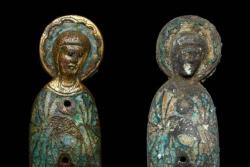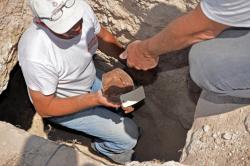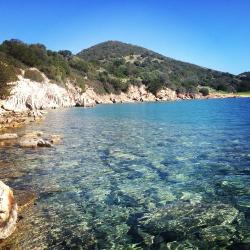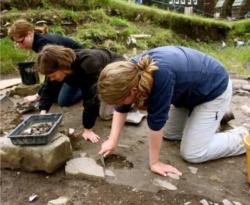INSTITUT SUPERIEUR D'ANTHROPOLOGIE
INSTITUTE OF ANTHROPOLOGY
ONLINE COURSES / COURS A DISTANCE
SUMMER TERM : JULY 2014
REGISTER NOW
DANEMARK - Søby- A Limoges statue of the Virgin Mary dating from the 13th century has been found during renovations of a small church in the eastern Jutland town of Søby. Archaeologist Hans Mikkelsen from the National Museum and a local craftsman were sifting through the soil under the church floor when they made the find. The icon would have probably sat atop a crucifix that was used in a church processional. There have been Limoges figures found in Denmark before, but likenesses of the Virgin Mary are quite rare and this is the first of the figures found in Denmark that has a halo. Limoges figurines were produced in the French town of the same name from 1200 to 1225. Mikkelsen feared that the figurine would have been much damaged by the passage of so many centuries, but a careful and thorough cleaning by National Museum conservator Signe Nygaard restored it beyond all expectations. “I could see the colours - the red in the halo and the beautiful blue-green nuances in the clothing,” Nygaard told Jyllands-Posten newspaper. “It is absolutely fantastic.”Nygaard said that it is “unbelievable” that such a rare figure was found in such a small church. “How the heck did it wind up here?” she exclaimed.
Søby- A Limoges statue of the Virgin Mary dating from the 13th century has been found during renovations of a small church in the eastern Jutland town of Søby. Archaeologist Hans Mikkelsen from the National Museum and a local craftsman were sifting through the soil under the church floor when they made the find. The icon would have probably sat atop a crucifix that was used in a church processional. There have been Limoges figures found in Denmark before, but likenesses of the Virgin Mary are quite rare and this is the first of the figures found in Denmark that has a halo. Limoges figurines were produced in the French town of the same name from 1200 to 1225. Mikkelsen feared that the figurine would have been much damaged by the passage of so many centuries, but a careful and thorough cleaning by National Museum conservator Signe Nygaard restored it beyond all expectations. “I could see the colours - the red in the halo and the beautiful blue-green nuances in the clothing,” Nygaard told Jyllands-Posten newspaper. “It is absolutely fantastic.”Nygaard said that it is “unbelievable” that such a rare figure was found in such a small church. “How the heck did it wind up here?” she exclaimed.
http://cphpost.dk/news/rare-statue-of-virgin-mary-found-buried-under-church-floor.9554.html?
CHYPRE –  Limassol - Three burial chambers estimated to be from the late Hellenistic period were accidentally discovered on Tuesday afternoon in a plot in Ayios Silas in Limassol. The tomb came to light when during landscaping works, an excavator hit the roof of a cave which collapsed and revealed skeletal remains, amphorae and coins. The Antiquities Department was notified by the police. So far, amphorae, seven skeletal remains and other small items were found. According to Yiannis Violaris, archaeologist of the Antiquities Department’s Limassol District, the tomb is estimated to be from the late Hellenistic period, between the second and first centuries BC, while modern day items which were found in the tomb are attributed to a probable older collapse of the roof. “Archaeologically, it is a very interesting area,” said Violaris, adding that there are several ancient monuments in the area and that there might be some connection to the tomb. “Northernmost where the church of Ayios Georgios of Viklios is today, there used to be an older temple and the Antiquities Department also found an ancient temple there, while nearby are the ruins of the Ayios Silas Monastery,” said Violaris. It will take approximately two to three days for the removal of all the findings from the site.
Limassol - Three burial chambers estimated to be from the late Hellenistic period were accidentally discovered on Tuesday afternoon in a plot in Ayios Silas in Limassol. The tomb came to light when during landscaping works, an excavator hit the roof of a cave which collapsed and revealed skeletal remains, amphorae and coins. The Antiquities Department was notified by the police. So far, amphorae, seven skeletal remains and other small items were found. According to Yiannis Violaris, archaeologist of the Antiquities Department’s Limassol District, the tomb is estimated to be from the late Hellenistic period, between the second and first centuries BC, while modern day items which were found in the tomb are attributed to a probable older collapse of the roof. “Archaeologically, it is a very interesting area,” said Violaris, adding that there are several ancient monuments in the area and that there might be some connection to the tomb. “Northernmost where the church of Ayios Georgios of Viklios is today, there used to be an older temple and the Antiquities Department also found an ancient temple there, while nearby are the ruins of the Ayios Silas Monastery,” said Violaris. It will take approximately two to three days for the removal of all the findings from the site.
http://cyprus-mail.com/2014/05/15/tomb-found-in-ayios-silas-in-limassol/?
GRECE –  Argolic Gulf - This new expedition is the result of a close collaboration between the Laténium in Neuchâtel, Switzerland, the Greek Ephorate of Underwater Antiquities, the Swiss School of Archaeology in Greece, and the Hellenic Centre for Marine Research. It aims to explore the prehistoric landscapes submerged in the Argolic Gulf in Greece, in an attempt to reconstitute them and perhaps to find traces of human activity. At the end of the last ice age, around 20,000 years ago, sea level was considerably lower than it is today. By studying these submerged prehistoric landscapes, archaeologists can reconstitute the environments that have disappeared under water and comprehend the interactions between prehistoric man and the sea. These studies, which are likely to become one of the major archaeological challenges of the 21st century, will enable to identify the mechanisms of population settlement in coastal areas.Recent work has demonstrated that navigation in the Eastern Mediterranean started much earlier than experts have imagined up to now. Indeed, it would appear that man navigated on the seas for the first time more than 100,000 years ago. This discovery would lead us to suggest that Greece played a key role in the rise of the Neolithic way of life (around 7,000 B.C.) as it spread from the Middle East into Europe. Scientists are thus interested in the spread of the Neolithic civilisation in Europe and in finding out how the nomadic, hunter-gatherer camps of the Palaeolithic and Mesolithic eras transformed into the sedentary villages of farmers of the Neolithic age. Julien Beck, researcher at the Classical Archaeology Unit at the UNIGE and TerraSubmersa scientific leader is fascinated about these questions : “ The Franchthi cave on the northern shore of Kiladha bay (Argolic Gulf) was occupied for some 35,000 years, from the Palaeolithic to the Neolithic ages. Such a surprisingly long period of occupation is an exception in Europe. The cave is therefore an ideal target for studying submerged prehistoric landscapes, since there must have been interactions between people there and the sea during these many thousands of years. Maybe we will find evidence of the very first European village”.
Argolic Gulf - This new expedition is the result of a close collaboration between the Laténium in Neuchâtel, Switzerland, the Greek Ephorate of Underwater Antiquities, the Swiss School of Archaeology in Greece, and the Hellenic Centre for Marine Research. It aims to explore the prehistoric landscapes submerged in the Argolic Gulf in Greece, in an attempt to reconstitute them and perhaps to find traces of human activity. At the end of the last ice age, around 20,000 years ago, sea level was considerably lower than it is today. By studying these submerged prehistoric landscapes, archaeologists can reconstitute the environments that have disappeared under water and comprehend the interactions between prehistoric man and the sea. These studies, which are likely to become one of the major archaeological challenges of the 21st century, will enable to identify the mechanisms of population settlement in coastal areas.Recent work has demonstrated that navigation in the Eastern Mediterranean started much earlier than experts have imagined up to now. Indeed, it would appear that man navigated on the seas for the first time more than 100,000 years ago. This discovery would lead us to suggest that Greece played a key role in the rise of the Neolithic way of life (around 7,000 B.C.) as it spread from the Middle East into Europe. Scientists are thus interested in the spread of the Neolithic civilisation in Europe and in finding out how the nomadic, hunter-gatherer camps of the Palaeolithic and Mesolithic eras transformed into the sedentary villages of farmers of the Neolithic age. Julien Beck, researcher at the Classical Archaeology Unit at the UNIGE and TerraSubmersa scientific leader is fascinated about these questions : “ The Franchthi cave on the northern shore of Kiladha bay (Argolic Gulf) was occupied for some 35,000 years, from the Palaeolithic to the Neolithic ages. Such a surprisingly long period of occupation is an exception in Europe. The cave is therefore an ideal target for studying submerged prehistoric landscapes, since there must have been interactions between people there and the sea during these many thousands of years. Maybe we will find evidence of the very first European village”.
http://cleantechnica.com/2014/05/14/planetsolar-terrasubmersa-expedition-2014-explore-submerged-prehistoric-landscapes/
ROYAUME UNI –  Bamburgh-The site itself is a microcosm of early Northumbrian history with evidence of day-to-day living in the form food preparation and consumption, manufacturing and recycling. There is also evidence of warfare, as defensive structures, weapons and armour have been unearthed. To the south of the castle there is a large Anglo-Saxon cemetery that likely served the castle’s inhabitants. Recent discoveries, which the students will be working on, include a metalworking building and a large timbered hall. The students will also be documenting the most important finds from the last few years, including locally produced Northumbrian styca coins, gold filigree mounts with close parallels to the Staffordshire hoard discovered in 2009, and a medieval belt buckle shaped like the Percy lion - the emblem of the Duke of Northumberland.
Bamburgh-The site itself is a microcosm of early Northumbrian history with evidence of day-to-day living in the form food preparation and consumption, manufacturing and recycling. There is also evidence of warfare, as defensive structures, weapons and armour have been unearthed. To the south of the castle there is a large Anglo-Saxon cemetery that likely served the castle’s inhabitants. Recent discoveries, which the students will be working on, include a metalworking building and a large timbered hall. The students will also be documenting the most important finds from the last few years, including locally produced Northumbrian styca coins, gold filigree mounts with close parallels to the Staffordshire hoard discovered in 2009, and a medieval belt buckle shaped like the Percy lion - the emblem of the Duke of Northumberland.
http://www.berwick-advertiser.co.uk/news/local/all-news/students-cross-the-pond-to-discover-bamburgh-history-1-3410753